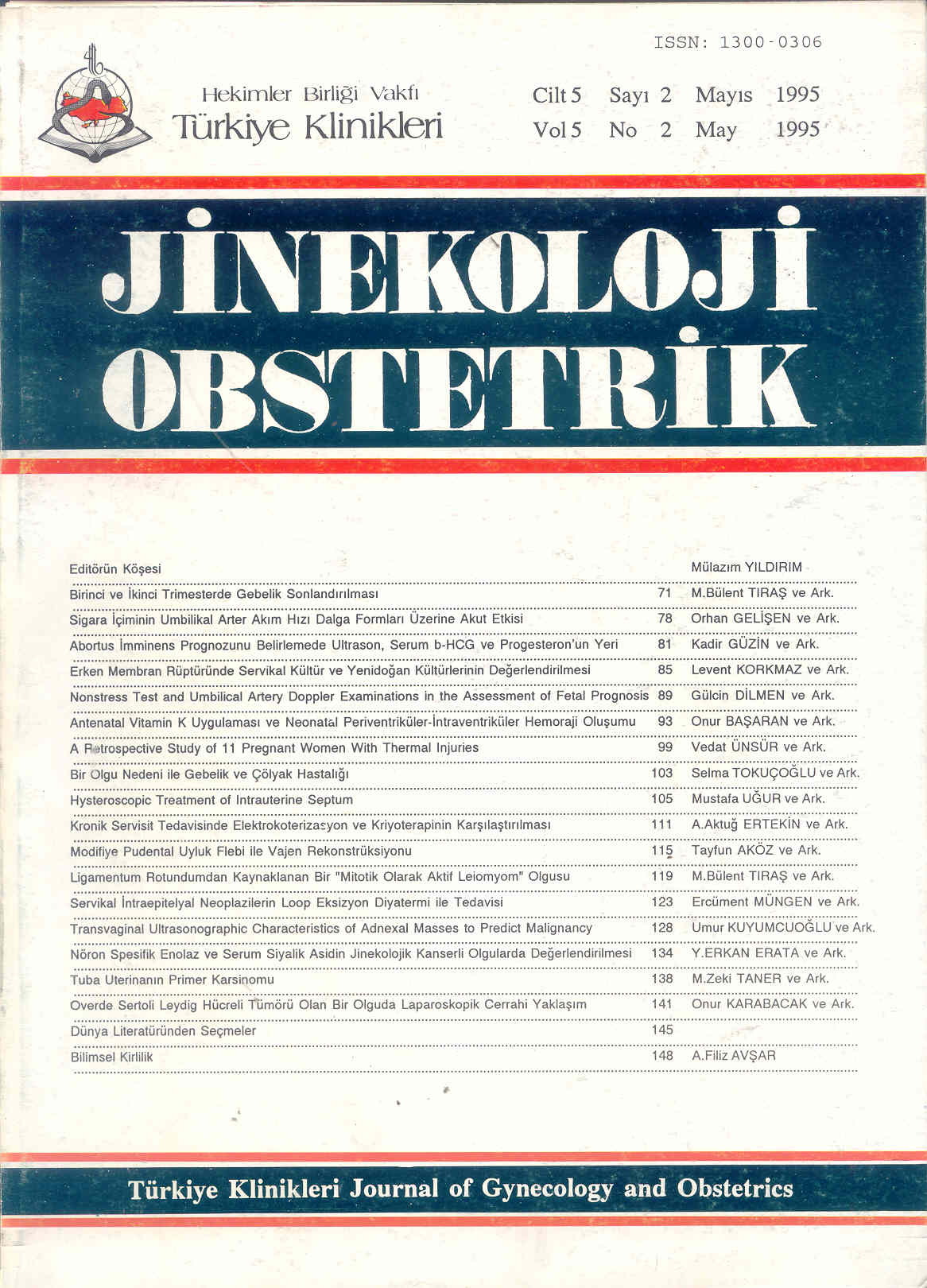Open Access
Peer Reviewed
ARTICLES
3484 Viewed1107 Downloaded
Hysteroscopic Treatment of Intrauterine Septum
İntrauterin Septumun Histeroskopik Tedavisi
Turkiye Klinikleri J Gynecol Obst. 1995;5(2):105-10
Article Language: TR
Copyright Ⓒ 2025 by Türkiye Klinikleri. This is an open access article under the CC BY-NC-ND license (http://creativecommons.org/licenses/by-nc-nd/4.0/)
ÖZET
Amaç: Histeroskopik septum rezeksiyonu uygulanan 41 hastanın semptomları, uygulanan teknik, komplikasyonları, post-operatif takip ve gebelik sonuçlarını araştırmak. Çalışmanın Yapıldığı Yer: Dr. Zekai Tahir Burak Kadın Hastanesi, Ankara. Materyel ve Metod: Ocak 1993 ve Ocak 1994 tarihleri arasında 41 hastaya genel anestezi altında laparoskopi eşliğinde histeroskopik septum kesilmesi operasyonu uygulandı. Distansiyon ortamı olarak %1.5 glisin kullanıldı; insizyon elektrokoter ile yapıldı. Primer infertilite ve tekrarlayan düşükler esas endikasyonları oluşturmaktaydı. Kırkbir hastanın ikisinde daha önceden abdominal yolla müdahele yapılmıştı. Bir hastada septum rezeksiyonunu takiben abdominal myomektomi uygulandı. İşlemden sonra tüm hastalara Rahim İçi Araç uygulandı ve bir ay süreyle estrojen+progesteron tedavisi verildi. Bulgular: Olguların çoğunda işlemden 1 ay sonra çekilen Histerosalpingografide düzelme saptandı. Kanama ve infeksiyon gözlenmedi. Bir hastada ise rezidüel septum sağlandığından ikinci bir histeroskopik müdahele yapıldı. Septum rezeksiyonundan sonra 12 hastada gebelik oluştu. Bunların 8 tanesi habitüel abortus, 3 tanesi primer infertilite grubundaydı. Halen devam eden 10 gebelik mevcuttur. Sonuç: Uterin septum nedeniyle elektrokoter kullanılarak uygulanan histeroskopik metroplasti, güvenli ve etkin bir cerrahi işlemdir. Komplikasyonların azlığı ve gebelik oranlarının yüksekliği bu işlemi daha önce opere edilen hastalarda dahi tercih nedeni yapmaktadır.
Amaç: Histeroskopik septum rezeksiyonu uygulanan 41 hastanın semptomları, uygulanan teknik, komplikasyonları, post-operatif takip ve gebelik sonuçlarını araştırmak. Çalışmanın Yapıldığı Yer: Dr. Zekai Tahir Burak Kadın Hastanesi, Ankara. Materyel ve Metod: Ocak 1993 ve Ocak 1994 tarihleri arasında 41 hastaya genel anestezi altında laparoskopi eşliğinde histeroskopik septum kesilmesi operasyonu uygulandı. Distansiyon ortamı olarak %1.5 glisin kullanıldı; insizyon elektrokoter ile yapıldı. Primer infertilite ve tekrarlayan düşükler esas endikasyonları oluşturmaktaydı. Kırkbir hastanın ikisinde daha önceden abdominal yolla müdahele yapılmıştı. Bir hastada septum rezeksiyonunu takiben abdominal myomektomi uygulandı. İşlemden sonra tüm hastalara Rahim İçi Araç uygulandı ve bir ay süreyle estrojen+progesteron tedavisi verildi. Bulgular: Olguların çoğunda işlemden 1 ay sonra çekilen Histerosalpingografide düzelme saptandı. Kanama ve infeksiyon gözlenmedi. Bir hastada ise rezidüel septum sağlandığından ikinci bir histeroskopik müdahele yapıldı. Septum rezeksiyonundan sonra 12 hastada gebelik oluştu. Bunların 8 tanesi habitüel abortus, 3 tanesi primer infertilite grubundaydı. Halen devam eden 10 gebelik mevcuttur. Sonuç: Uterin septum nedeniyle elektrokoter kullanılarak uygulanan histeroskopik metroplasti, güvenli ve etkin bir cerrahi işlemdir. Komplikasyonların azlığı ve gebelik oranlarının yüksekliği bu işlemi daha önce opere edilen hastalarda dahi tercih nedeni yapmaktadır.
ANAHTAR KELİMELER: Metroplasti, histeroskopi, uterin septumu
ABSTRACT
Objective: To present the results of hysteroscopic septum resection of 41 patients including the technique used, complications, postoperative follow-up and pregnancy results. Institution: Dr. Zekai Tahir Burak Women's Hospital, Ankara. Material and Methods: Between January 1993 and January 1994, forty-one patients underwent hysteroscopic division of the uterine septum monitored by concomitant laparoscopy. All procedures were performed under general anesthesia. Uterine cavity was distended with 1.5% glycine and electrocautery was used for the incision of the septa. Recurrent abortion and primary infertility were the main indications for septum resection. Two of the forty-one patients had previous unsuccessful abdominal operations for the correction of the uterine anomaly. In one patient hysteroscopic division of the septum was followed by abdominal myomectomy for a concomitant intramural myoma in the same session. Intrauterine device was applied and sequential estrogen+progesterone therapy was given for 1 month in all patients. Results: The procedure was carried out successfully in most of the cases which was verified by hysterosalpingography performed one month after the operation. No hemorrhage or infection was observed. One patient required a second hysteroscopic operation because a partial residual septum was observed on the post treatment hysterogram. There were a total of 18 pregnancies after a mean period of 14.6 months following the procedure, of which 11 (61.1%) were carried to term, 3 (16.6%) ended with spontaneous abortion, and 4 (23:%) are ongoing. Conclusion: Hysteroscopic metroplasty using electrocautery, is a safe and effective procedure for the treatment of uterine septum even in patients who had a previous laparotomy for the correction of the anomaly. It has few complications and satisfactory pregnancy results.
Objective: To present the results of hysteroscopic septum resection of 41 patients including the technique used, complications, postoperative follow-up and pregnancy results. Institution: Dr. Zekai Tahir Burak Women's Hospital, Ankara. Material and Methods: Between January 1993 and January 1994, forty-one patients underwent hysteroscopic division of the uterine septum monitored by concomitant laparoscopy. All procedures were performed under general anesthesia. Uterine cavity was distended with 1.5% glycine and electrocautery was used for the incision of the septa. Recurrent abortion and primary infertility were the main indications for septum resection. Two of the forty-one patients had previous unsuccessful abdominal operations for the correction of the uterine anomaly. In one patient hysteroscopic division of the septum was followed by abdominal myomectomy for a concomitant intramural myoma in the same session. Intrauterine device was applied and sequential estrogen+progesterone therapy was given for 1 month in all patients. Results: The procedure was carried out successfully in most of the cases which was verified by hysterosalpingography performed one month after the operation. No hemorrhage or infection was observed. One patient required a second hysteroscopic operation because a partial residual septum was observed on the post treatment hysterogram. There were a total of 18 pregnancies after a mean period of 14.6 months following the procedure, of which 11 (61.1%) were carried to term, 3 (16.6%) ended with spontaneous abortion, and 4 (23:%) are ongoing. Conclusion: Hysteroscopic metroplasty using electrocautery, is a safe and effective procedure for the treatment of uterine septum even in patients who had a previous laparotomy for the correction of the anomaly. It has few complications and satisfactory pregnancy results.
MENU
POPULAR ARTICLES
MOST DOWNLOADED ARTICLES





This journal is licensed under a Creative Commons Attribution-NonCommercial-NoDerivatives 4.0 International License.










